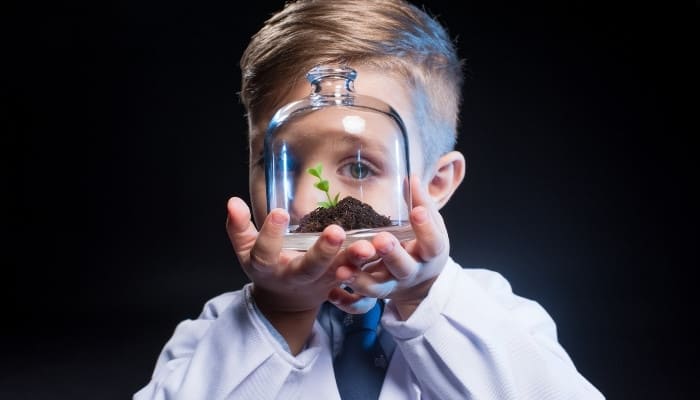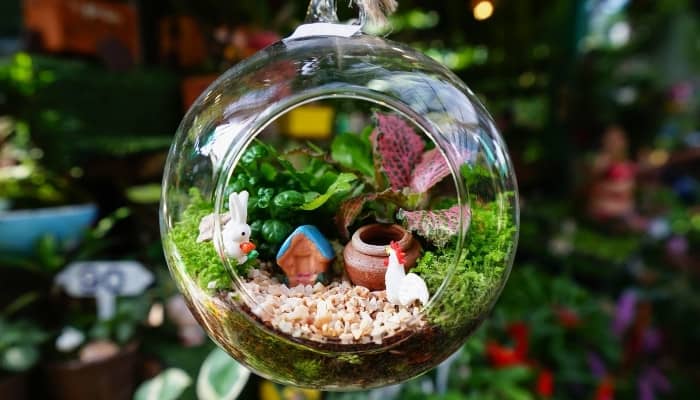Adding water to your terrarium may seem like a straightforward task with the glass enclosure, but if you do not research beforehand, it could lead to a messy situation.
Can terrariums hold water? The ability of a terrarium to hold water depends on several factors, including the design, the material from which the terrarium is made, the thickness and strength of the glass, the type of sealant used in construction, the terrarium’s weight limit, and the position of the opening.
Let’s discuss the factors that affect a terrarium’s ability to contain water. We’ll also go over several types of terrariums, including which ones are the best for this task.
Terrariums and Water – What You Need To Know
To begin, a terrarium is most traditionally used to house plants and small land-based animals such as snakes and insects.
Since this is their primary use, it can be challenging to find a container that will support the weight of water.
However, some varieties of these tanks are built to handle those weights or can be modified for that purpose.
Factors That Determine If a Terrarium Can Hold Water
Elements of a tank’s composition will determine most of its pertinent characteristics, including its liquid-bearing ability.
Generally speaking, if the container was originally designed to hold water, you should be able to use it as a terrarium with a water feature of some type.
If the container was originally designed to house only plants, it may or may not hold water reliably. You must consider the terrarium material, thickness, sealant type, weight limit, and overall shape.
Material
Terrariums typically consist of either glass, plastic, or a hybrid such as plexiglass. Some varieties of glass are porous, but plastic materials are watertight.
Many tanks housing varieties of plants use materials that encourage condensation and drain into a dish or false bottom.
A plastic or plexiglass terrarium is the ideal choice for effective sealing. Otherwise, ensure that the glass is solid and not designed for ventilation or drainage.
Thickness of the Glass
Glass panels in tanks sometimes fit together irregularly, but thicker glass helps make up for errors and integrity problems.
To have a water-bearing terrarium, your tank should have glass about as thick as a standard aquarium. This range is from 0.5 millimeters to 1 millimeter.
Thick glass also provides durability for the terrarium, which will be essential for bearing large volumes of liquid. Make sure your tank is at least 0.5 millimeters thick before continuing.
Type of Sealant
Since terrariums are subject to welding errors and joint gaps, the type of sealant they use is critical.
Some terrariums use clear acrylic glaze on the inside to help reinforce the structure, but this doesn’t hold up after long-term liquid exposure.
A 100% silicone sealant is an effective choice for securing the corners of the tank.
If you are going to apply or reapply sealant to a tank, remember to thoroughly clean it first as dust and dirt particles can create gaps that result in leaks.
Weight Limit
How much weight a terrarium can handle depends on its size, glass thickness, and reinforcements. Well-made tanks, like the Exo-Terra, can hold over 25 pounds, which is equivalent to at least 3 gallons of water.
A small aquarium contains around five gallons of water with strong reinforcing structures, thick glass, and tough sealant.
Many terrariums will not hold as much water as an aquarium, but you can modify one for that purpose.
Position of Opening
Lastly, consider the position of the terrarium’s openings. A closed tank usually only has an opening at the top, which can be sealed with a screen, left open, or covered with another panel.
Terrariums with openings on the side will not be able to reliably hold water unless the water is confined to a small dish or tray of some sort.
An open terrarium is more abstract and can have an avenue anywhere on the outside. Open terrariums usually house small plants and succulents and should not hold any water.
Types of Terrariums & Their Ability To Hold Water

Here is a brief overview of terrarium types and their water-bearing capabilities.
Open Terrariums
- Lightweight, designed for small plants
- One or more openings around its shape
- Not suited for holding water
Closed Terrariums
- Heavyweight
- Generally used for housing land-based animals
- Can hold some water and can be modified to hold more
Tropical Plant Terrarium
- Sturdy, designed for rearing tropical plants and animals
- Made with thin glass and sealed to create artificial water cycles inside
- Not suited for holding lots of water
Screened Enclosures
- Durable and suitable for housing many types of plants and smaller reptiles
- Has a screen over the top to further help with ventilation
- Not designed to hold water or humidity
Aquarium
- Very heavy, designed to hold at least 5 gallons of water
- Suitable for aquatic life
- Multiple layers of sealant
Considerations Before Adding Water to a Terrarium
First, know the material and thickness of your tank’s glass. If it is constructed of plastic, PVC, or one millimeter-thick glass, it’s suitable for holding water.
Administer a small amount of water. Examine any drainage or leakage that occurs. If you notice any leakage, reapply silicone sealant on the corners liberally.
Consider the tank’s weight as well. If the dimensions are small and the corners are not reinforced by rubber or metal welded pieces, it may not stand the weight of water.
Best Terrariums for Holding Water
Most closed terrariums can be repurposed by reapplying sealant and swapping out thin glass panels for thicker ones.
Varieties like aquariums and paludariums are best suited for holding large volumes of water. You can repurpose any thick plastic or glass tank as a water-bearing terrarium.
In general, commercially-sold animal terrariums are the most durable, such as the Exo-Terra.
Others, like the Zilla Tropical Reptile Enclosure, can hold a certain volume of water, effectively creating a miniature paludarium.
A small plant terrarium can come from recycled materials like soda bottles, vases, and fish tanks. Each of these is designed to keep liquid inside and should have no integrity issues.
However, smaller terrariums won’t be able to hold very much water.
Related Questions:
Are Terrariums Waterproof?
Not all terrariums are waterproof. Some feature porous glass for ventilation or drainage, especially tropical tanks. Others were simply not designed to hold water at all.
In this case, you can add small dishes of water to increase the humidity of the terrariums if that is your goal.
What Is a Paludarium?
A paludarium is a hybrid terrarium that encapsulates both aquatic and land-based life. They are ideal for housing miniature rainforest or waterside ecosystems for reptiles such as turtles.
Wrapping It Up
Now you know more about terrarium types and their water-bearing capabilities. Whether or not a terrarium can hold water isn’t straightforward.
You have to consider the glass thickness, weight limit, and more. However, with so many varieties of terrariums, you are bound to find one that suits your exact needs.
Sources:
https://www.ambius.com/learn/plant-doctor/ultimate-guides/ultimate-guide-to-terrariums/
https://terrariumtribe.com/terrarium-false-bottom/
https://www.aquariumfocus.com/fish-tank-glass-thickness-guide/
https://www.thesprucepets.com/aquarium-sizes-and-weights-1380694
https://www.terrariumquest.com/vivarium/rainforest-vivarium/tank/

